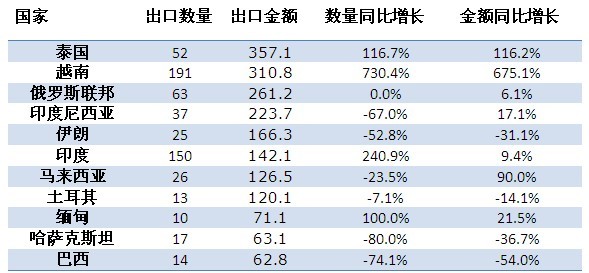
In July, China imported 138 extruders, and the import amount was 36.99 million US dollars. The import volume increased by 35.3% year-on-year, the import amount decreased by 37.2%; the export extruder reached 1,092 units, the export amount was 29.91 million US dollars, and the export volume increased by 9.3%. %, the export amount was basically the same as last year.
Since the beginning of this year, the export of China’s extruders has experienced a substantial decline. From the data of January to July, the rate of decline has been around 7.8%. At the same time, we also noticed that the export of extruders was the only decline in the total exports of presses in the first half of the year, and the continued decline in export unit prices was a major issue for the development of extruders, despite a large increase in exports in July. However, the export amount still cannot be improved.
Table: Export Machine Export Country or Region in July, Unit: 10,000 US dollars, Taiwan

Russia has always been a big consumer of China's extruders. Due to the poor domestic economic environment and the sluggish investment and consumption in Russia during the first half of this year, the extruder also experienced a decline of about 15%, but it still had a 6.1% year-on-year increase in July. .
It is worth noting that in the Vietnam market, Vietnam’s import extruder from China before this year was not very large overall, but this year its import amount has been continuously rising, and its investment in building materials such as sheet and sheet is increasing. In July, the amount of extruders imported from China increased by nearly 7 times year-on-year. Despite this year's macroeconomic instability in Vietnam, high interest rates have made credit growth slow, and total social investment has been difficult to achieve. However, according to data from the General Bureau of Statistics of Vietnam, the industrial production index in Vietnam rose sharply in January of this year, an increase of 21.1% year-on-year, and the industrial industry has a positive signal of its recovery.
In fact, Vietnam’s current domestic investment is relatively small, and the majority of its investment comes from abroad. In January, total foreign direct investment amounted to about 281 million U.S. dollars, an increase of 74% year-on-year, and foreign direct investment registered capital of processing and manufacturing industries was 203 million U.S. dollars, accounting for 72.1% of the total amount of registrations. Many companies, including Japan, expressed their desire to continue investing in Vietnam.
Due to the strong investment from abroad and the strong domestic demand, this situation will continue for at least some time. Therefore, in the following period, Vietnam’s demand for plastic processing equipment will increase. (Zhuo Shang Plastic Net http://plas.w7000.com)
While SAPP is generally considered safe for consumption, it is important to note that excessive consumption can lead to an imbalance in the body's electrolytes, which can cause health problems. It is therefore important to consume SAPP in moderation and in accordance with recommended guidelines.
Food Grade SAPP stands for Sodium Acid Pyrophosphate, which is a white, odorless powder used as a leavening agent in baked goods, such as cakes, bread, and pastries. It is also used as a preservative in canned fruits and vegetables, and as a sequestrant in processed cheese and dairy products. Food Grade SAPP is considered safe for consumption by the FDA and is commonly used in the food industry.
Sodium acid pyrophosphate (SAPP) is a white crystalline powder that is commonly used as a leavening agent in baked goods. It is also used as a buffering agent, emulsifier, and sequestrant in various food applications.
SAPP is a water-soluble salt that is composed of sodium cations and pyrophosphate anions. It is an acidic compound with a pH of around 4.5 to 5.5, which makes it useful in controlling the pH of food products.
In baked goods, SAPP reacts with baking soda to produce carbon dioxide gas, which helps the dough or batter rise. It is often used in conjunction with other leavening agents like baking powder or yeast to achieve the desired texture and volume.
SAPP is also used in processed cheese products to prevent the cheese from melting too quickly and to improve its texture. It is also used in meat products to improve their texture and juiciness.
While SAPP is generally recognized as safe by the FDA, excessive consumption of foods containing SAPP may lead to gastrointestinal distress. It is important to follow recommended usage levels and to consult with a healthcare professional if you have any concerns about your diet.
Sodium Acid Pyrophosphate SAPP Food Grade, Sodium Acid Pyrophosphate In Food, Sodium Acid Pyrophosphate SAPP Baking Powder
Sichuan Jinhe Qihang Co,. Ltd. , https://www.jinhechemicals.com